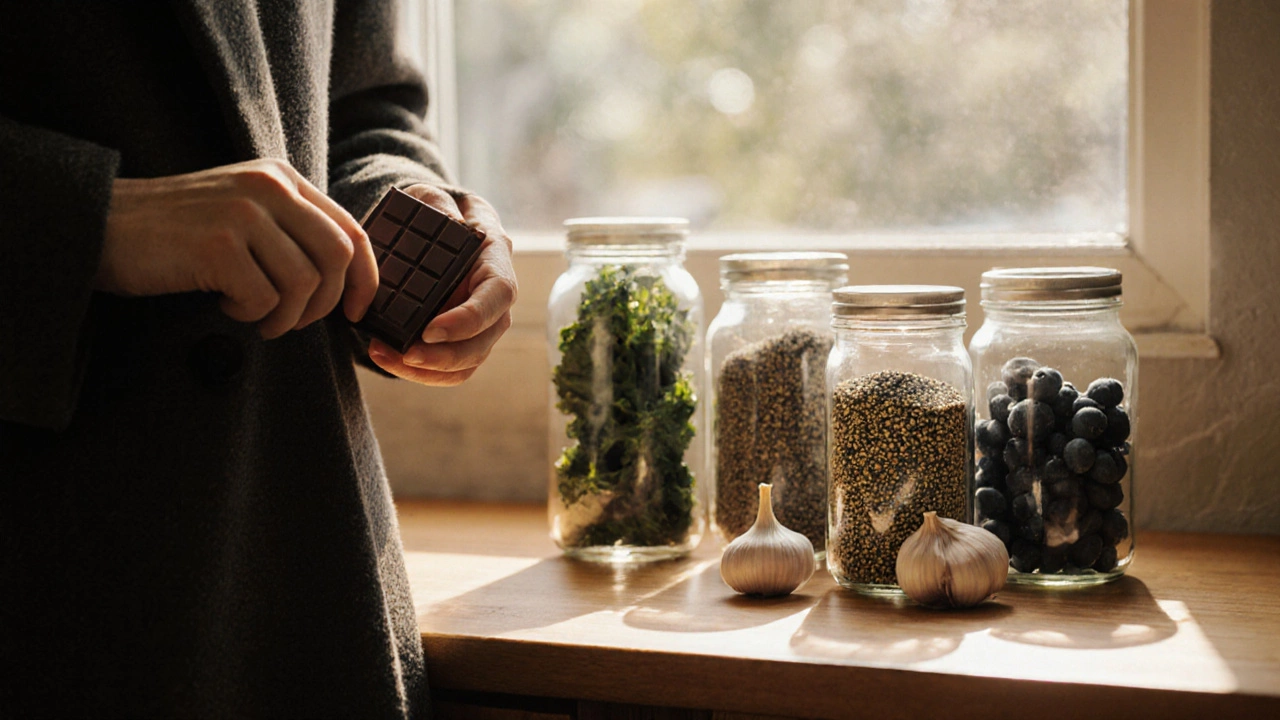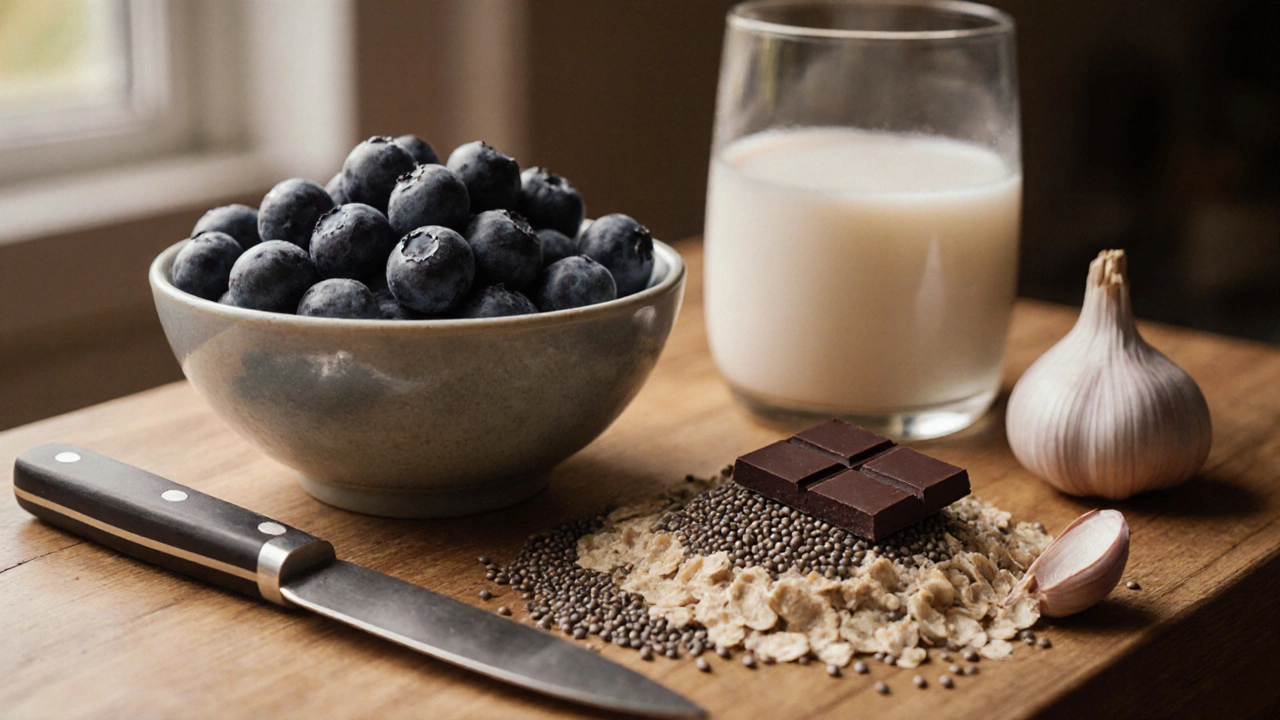Superfood Nutrient Calculator
Track Your Superfood Intake
Enter your daily servings of the 7 superfoods to see how they contribute to your nutrient intake.
Nutrient Breakdown
Tip: Aim for at least 3 superfoods per day. These nutrients work best as part of a varied diet.
Forget fancy supplements and expensive pills. The real magic for feeling better, having more energy, and staying healthy is already in your kitchen. You don’t need to buy exotic imports or follow strict diets. Just add these seven real, whole foods to your meals regularly-and you’ll notice the difference. These aren’t just trendy buzzwords. They’re foods backed by decades of research, eaten for centuries in cultures around the world, and packed with nutrients your body actually needs.
Blueberries
They’re small, sweet, and easy to toss into oatmeal, yogurt, or smoothies. But don’t let their size fool you. Blueberries are one of the most antioxidant-rich fruits on the planet. A single cup gives you more than 20% of your daily vitamin C and a heavy dose of anthocyanins-the compounds that give them their deep blue color and fight inflammation. Studies show people who eat blueberries regularly have better memory and lower blood pressure. I keep a container in my fridge year-round. Even frozen ones work just as well. Throw them in your morning bowl, blend them with spinach and almond milk, or eat them plain. No cooking needed.
Kale
Kale isn’t just the leafy green that shows up in every Instagram salad. It’s a nutrient powerhouse. One cup of chopped raw kale has more vitamin K than your body needs for the whole day. It’s also loaded with vitamin A, calcium, and fiber. Unlike spinach, kale holds up well to cooking, so you can sauté it with garlic, roast it into crispy chips, or add it to soups and stews. I learned this the hard way: raw kale in a smoothie tastes like grass if you don’t prep it right. Massage the leaves with a little olive oil and lemon juice for 30 seconds first. It softens them, removes the bitterness, and makes them way more enjoyable. If you’re not eating kale at least three times a week, you’re missing out on one of the most efficient ways to boost your micronutrient intake.
Salmon
When it comes to brain and heart health, nothing beats wild-caught salmon. It’s one of the few natural food sources of omega-3 fatty acids-specifically EPA and DHA-that your body can’t make on its own. These fats reduce inflammation, lower triglycerides, and support mood and cognitive function. The NHS recommends eating two portions of fish per week, with one being oily. Salmon fits perfectly. I buy frozen fillets from the supermarket-they’re just as good as fresh and cheaper. Bake them with lemon and dill for 12 minutes, or pan-sear them skin-side down until crispy. Serve with roasted sweet potatoes and steamed broccoli. Simple. Satisfying. Supercharged.
Quinoa
Quinoa isn’t a grain. It’s a seed. But it cooks like rice and tastes nutty and light. What makes it special? It’s one of the very few plant foods that contains all nine essential amino acids, making it a complete protein. That’s rare. Most plant proteins are missing one or two. Quinoa also gives you magnesium, iron, and fiber-about five grams per cooked cup. It’s gluten-free, too, so it’s perfect for anyone avoiding wheat. I use it as a base for bowls: toss it with black beans, corn, avocado, lime, and cilantro. Or swap it for rice in stir-fries. Rinse it well before cooking-it has a natural coating called saponin that can taste bitter if you don’t wash it off.

Chia Seeds
These tiny black seeds look like poppy seeds, but they do a lot more. When soaked in liquid, they swell up and form a gel. That’s because they’re packed with soluble fiber-10 grams per ounce. That’s more than most whole grains. Chia seeds also give you omega-3s (ALA form), calcium, and antioxidants. They’re flavorless, so you can sprinkle them on anything: yogurt, oatmeal, salads, even baked goods. My favorite trick? Make chia pudding. Mix three tablespoons of chia seeds with one cup of almond milk, a dash of vanilla, and a spoon of honey. Let it sit overnight in the fridge. In the morning, you’ve got a thick, creamy breakfast that keeps you full for hours. No cooking. No mess. Just pure, slow-releasing energy.
Dark Chocolate (70% or higher)
Yes, chocolate counts. But only the kind with at least 70% cocoa. Regular milk chocolate? It’s sugar with a hint of cocoa. Real dark chocolate is rich in flavonoids-plant compounds that improve blood flow and lower blood pressure. A 2023 meta-analysis in the European Journal of Clinical Nutrition found that people who ate small amounts of high-cocoa chocolate daily had significantly better arterial function. I keep a bar in my desk drawer. After lunch, I eat two squares. It satisfies my sweet tooth without spiking my blood sugar. Look for brands with minimal ingredients: cocoa mass, cocoa butter, sugar, maybe vanilla. No soy lecithin, no artificial flavors. If it tastes bitter, that’s a good sign. You’re getting the good stuff.
Garlic
Garlic is the unsung hero of the kitchen. Crush or chop it and let it sit for 10 minutes before cooking. That activates allicin, the compound responsible for its immune-boosting and antimicrobial powers. Studies show garlic can reduce the severity and duration of colds. It also helps lower LDL cholesterol and has anti-inflammatory effects. I use it in almost everything: roasted vegetables, soups, pasta sauces, even scrambled eggs. I don’t just add a clove-I add three or four. The more, the better. Roast whole heads with olive oil until soft and spreadable. Mix it into hummus. Toss it with potatoes before baking. Don’t be afraid of the smell. It’s the smell of health.

How to Actually Use These Foods
Knowing what superfoods are is one thing. Eating them regularly is another. Most people buy kale, then let it wilt in the fridge. They buy chia seeds, forget they exist, and toss them out six months later. Here’s how to make this stick:
- Plan one meal a day around one of these foods. Breakfast is easiest-blueberries in oatmeal, chia pudding, or scrambled eggs with garlic.
- Keep frozen blueberries and pre-washed kale on hand. They last longer and are just as nutritious.
- Buy salmon in bulk and freeze portions. Thaw overnight in the fridge.
- Store chia seeds and quinoa in airtight containers in the pantry. They won’t go bad for months.
- Use garlic like salt-add it early and often. Don’t wait for special occasions.
- Keep a small piece of dark chocolate in your bag. It’s a healthy snack when cravings hit.
You don’t need to eat all seven every day. Just pick three. Rotate them. Make them part of your routine, not your checklist.
What About Other Superfoods?
You’ll hear about a lot more: acai, goji berries, matcha, spirulina, turmeric. Some are great. But they’re often expensive, hard to find, or overhyped. The seven listed here are accessible, affordable, and proven. You can buy them at any UK supermarket. You don’t need to order them online. You don’t need to be a foodie. You just need to start using them.
Real Results, Not Hype
People ask me: ‘Will these foods make me lose weight?’ Maybe. ‘Will they cure my fatigue?’ Possibly. ‘Will they fix my digestion?’ Often. But the real benefit isn’t one big change. It’s the cumulative effect. Eating these foods means you’re eating less processed junk. You’re getting more fiber, more vitamins, more healthy fats. Your body starts to run smoother. You sleep better. You don’t crash after lunch. Your skin clears up. You feel lighter. Not because you’re dieting. Because you’re nourishing yourself.
These aren’t magic pills. They’re food. Real food. Eat them. Notice how you feel. Then eat them again.
Are superfoods really that different from regular healthy foods?
The term ‘superfood’ isn’t a scientific classification-it’s a marketing label. But the foods called superfoods are genuinely nutrient-dense. They pack more vitamins, minerals, antioxidants, and healthy fats per calorie than most other foods. Blueberries, kale, salmon, and garlic aren’t special because of a label. They’re special because they deliver more bang for your bite. You can get similar benefits from other whole foods, but these seven are among the most efficient.
Can I eat too many superfoods?
It’s possible, but unlikely with whole foods. Eating five cups of kale a day might upset your stomach or interfere with thyroid function if you have an iodine deficiency. Too much dark chocolate can add extra sugar and calories. But the real risk isn’t overeating superfoods-it’s thinking they’re a cure-all. You still need balance. A diet of only blueberries and chia seeds isn’t healthy. These foods work best as part of a varied, whole-food diet.
Are frozen superfoods as good as fresh?
Yes, often better. Frozen blueberries, kale, and even salmon are flash-frozen at peak ripeness, locking in nutrients. Fresh produce can lose vitamins during transport and storage. Frozen options are cheaper, last longer, and reduce waste. Use frozen berries in smoothies, frozen kale in soups, and frozen salmon for quick meals. No need to pay extra for ‘fresh’ when frozen works just as well.
Do I need to buy organic versions of these superfoods?
Organic is nice, but not essential. For kale and blueberries, the Environmental Working Group lists them as low-risk for pesticide residue, even when conventionally grown. Salmon is less likely to have pesticide issues than land animals. Garlic is rarely sprayed. If you’re on a budget, prioritize buying organic for foods on the ‘Dirty Dozen’ list (like strawberries or spinach), but don’t stress over these seven. Eating them non-organic is still far better than not eating them at all.
How long until I notice a difference?
Some people feel it in days-better digestion, more stable energy. Others take weeks. It depends on your starting point. If you’re eating a lot of processed food, switching to these whole foods will make a noticeable difference in how you feel after meals, your focus during the day, and even your sleep. Don’t wait for a miracle. Just keep adding them. The changes are subtle at first, but they add up.

